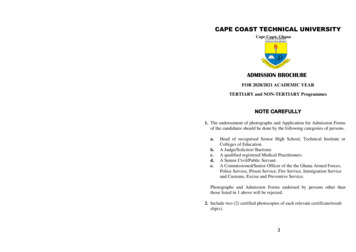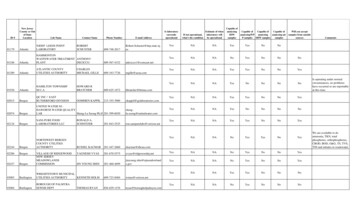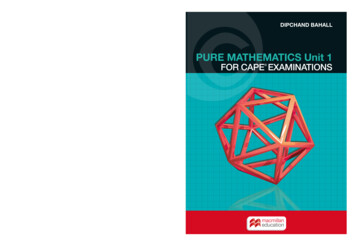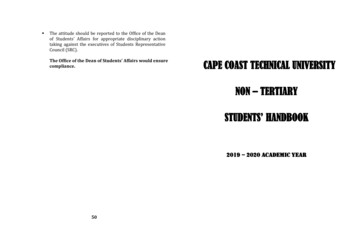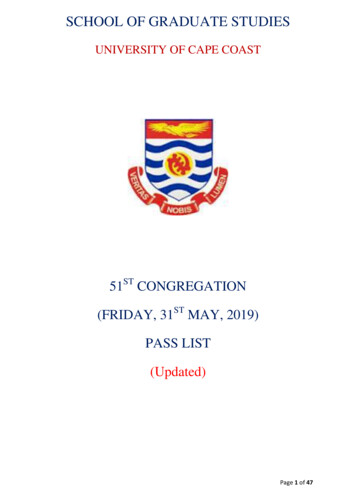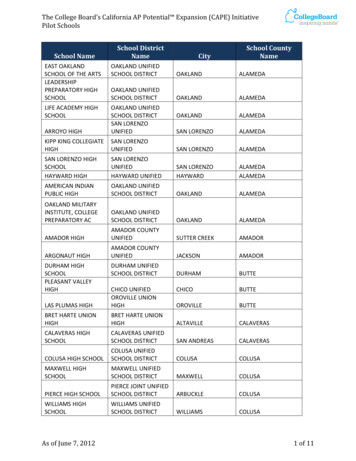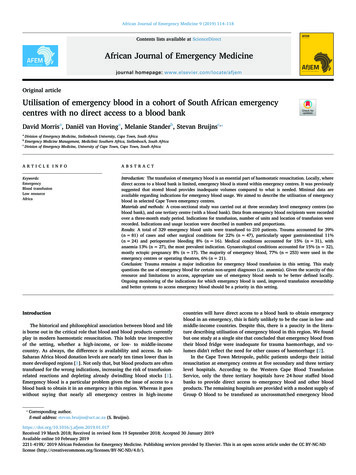
Transcription
UNIVERSITY OF CAPE COASTASSESSING TEACHING EFFECTIVENESS OF THE ENGLISH GRAMMAR TEACHER INPUBLIC SENIOR HIGH SCHOOLS WITHIN THE CAPE COAST METROPOLIS USINGTHE QUALITY TEACHING MODELOBED ATTA-ASAMOAHJENNIFER EMEFA DOEVICTOR NARH TEKPETEYEUNICE HEPZIBAH AMPROFI BOHAM2014
UNIVERSITY OF CAPE COASTASSESSING TEACHING EFFECTIVENESS OF THE ENGLISH GRAMMAR TEACHER INPUBLIC SENIOR HIGH SCHOOLS WITHIN THE CAPE COAST METROPOLIS USINGTHE QUALITY TEACHING MODELBYOBED ATTA-ASAMOAHJENNIFER EMEFA DOEVICTOR NARH TEKPETEYEUNICE HEPZIBAH AMPROFI BOHAMProject Work Submitted to the Department of Arts and Social Sciences Education (DASSE) ofthe Faculty of Education, University of Cape Coast, in Partial Fulfilment of the Requirements forthe Award of the Bachelor of Education (Arts) Degree.May 2014
DECLARATIONSCandidates’ DeclarationWe hereby declare that this project work is the result of our own originalresearch and that no part of it has been presented for another degree in thisuniversity or elsewhere.Candidates’ NameSignatureDateOBED ATTA-ASAMOAH. . JENNIFER EMEFA DOE VICTOR NARH TEKPETEY . EUNICE HEPHZIBAH AMPROFI BOHAM .Supervisor’s DeclarationI hereby declare that the preparation and presentation of the project work weresupervised in accordance with the guidelines on supervision of project work laiddown by the University of Cape Coast.Supervisor’s Signature: .Name: Dr. Ekua Tekyiwa Amua-SekyiiiDate:
ABSTRACTThe focus of this study was to assess the teaching effectiveness of EnglishGrammar teachers in public Senior High Schools within the Cape CoastMetropolis using the Quality Teaching Model. It sought to ascertain howappropriately the three dimensions of the Quality Teaching Model are addressedin the teaching and assessment practices of the teachers.45 English Grammar teachers were selected using the census method. Thedescriptive research design was used to analyse data collected on teachers. Themean, frequencies and percentages were thoroughly discussed.It came to light that to a very large extent, English Grammar teachersappropriately teach to produce deep understanding of important concepts andideas. It was also realized that they create a supportive learning environment fortheir students. Largely, learning is made more meaningful and important tostudents. It was recommended that teachers be motivated to maintain a balanceand consistency in the use of the three dimensions of the Quality Teaching Model.iii
ACKNOWLEDGEMENTSOur profound gratitude goes to Dr. Ekua Tekyiwa. Amua-Sekyi, ourproject supervisor for her tenacity in making this project a success. Her immensesupport has made this work possible.We shall forever be indebted to Mr. Eric Mensah of the Department ofArts and Social Sciences Education, University of Cape Coast, Cape Coast. Hisvaluable contribution and tutelage has made the production of this work possible.We are grateful.We are also thankful to Mr. Eric Kafui Bansah for his numeroussuggestions and to all teachers of English in the Senior High Schools within theCape Coast Metropolis for their assistance. To all who contributed in diverseways to make this work a success, we are ever grateful.Finally, we are grateful to all authors whose work we have cited. We wishto submit that we accept full responsibility for the content and any shortcoming inthis work.iv
DEDICATIONTo our families, relatives and friends.v
TABLE OF EDGEMENTSivDEDICATIONvLIST OF TABLESxLIST OF FIGURESxiCHAPTERONE INTRODUCTION1Introduction1Background to the study1Statement of the Problem3Purpose of the Study4Research Questions5Significance of the Study5Delimitation of the Study6vi
Limitations of the Study6Organization of the rest of the Study6TWO REVIEW OF RELATED LITERATURE8Introduction8The Concept of Teaching8The Teaching and Learning Process9Effective Teaching11Relevance of Teaching Grammar15Models of Teacher Effectiveness16The New South Wales Quality Teaching Model18Intellectual Quality19The Quality Learning Environment24Significance28THREE METHODOLOGY34Research Design34Profile of Cape Coast Metropolis35Population36vii
Sample and Sampling Procedure37Instrumentation37Validity and Reliability38Data Collection Procedure38Data Analysis39FOUR RESULTS AND DISCUSSION40Introduction40Demographic Background of the Respondents40Main Results43Research Question One43Research Question Two48Research Question Three52Discussion57Research Question One57Research Question Two58Research Question Three59FIVE SUMMARY, CONCLUSIONS AND RECOMMENDATIONSviii60
s62REFERENCES63APPENDICES67APPENDIX A:Letter of Introduction68APPENDIX B:Questionnaire for Teachers69ix
LIST OF TABLESTablePage1Gender of Respondents402Highest Professional Qualification413Age Range414Number of Years Taught in Senior High School425How appropriate English Grammar teachers address44the elements of intellectual quality6How appropriate English Grammar Teachers49Create Supportive Learning Environment for Students7How Appropriate English Grammar Teachers makeLearning Meaningful to Studentsx54
LIST OF FIGUREFigure1PageThe Triadic Relationship of Teachingxi9
CHAPTER ONEINTRODUCTIONIntroductionThis section sought to look at the background of the study, statementof the problem, purpose of the study, research questions, significance,limitations and delimitations of the study.Background to the StudyGhana is a heterogeneous society with a wide variety of languages.Undisputedly, English is the official language of the country. The emergenceof the language dates back to the early 16th century, with the arrival of theEuropean traders on the shores of Ghana and the establishment of missionaryschools. For over five centuries, English language has been the dominantlingua franca in Ghana. It is the medium of instruction in our educationalsetting and a pre-requisite course for entry into any higher level of education.It ensures full participation in the economic, political and even social lives ofthe people. It is the language of government, administration, business,medicine, law and other professional careers. The increasing importance of thelanguage is largely recognized in Ghana. It is for these reasons that allstakeholders of education are bent on ensuring that all aspects of the language1
are taught and learnt at school. It is therefore necessary that teachers aretrained purposively for this task. Some people think there is no such thing aslanguage teaching. Even if true, there are still things that can be done to helplearners acquaint themselves with the basic rules that form the basis orfoundations of a language. Teachers are therefore charged with the duty toexpose students enough to the language. Arends (1988) stated that the baseline for effective teaching are individuals who are academically able, havecommand of the subjects they are required to teach and those who can helpstudents to attain high level of academic achievement and social learning.Even though the language has become a widely acclaimed medium ofcommunication and one would have expected a high level of the languageusage in our societies, however, there has been a general view that there is adecline in the standard of the English language. This has resulted in the pooruse of the language which is evident in the performance in the language atexaminations. The external examination body, West African ExaminationsCouncil (WAEC), stated in their 2006 chief examiner’s report that Englishlanguage was one of the subject areas that saw a decline in the performance oftheir students. Out of the 120,486 students who sat for the English languagepaper, only 7.25% had a pass mark. Similarly the 2007, 2008 and 2009 chiefexaminer’s report of the WAEC states that students recurring weakness ofpoor grammar has been a worry to them. The WAEC stated together withother recommendations that the surest way of solving this persistent problemis for the teachers to teach grammar.2
Most people have attributed the decline in the standard of the Englishlanguage to several factors. While others find fault with the teacher’s inabilityto handle the subject well, others talk about the insufficient teaching andlearning materials at the teacher’s disposal; others also attribute it to the lowmotivation given to the teachers. If any of these perceptions are true, it will beappropriate that the current state of the art of teaching the language, especiallygrammar, be assessed to determine the extent of the effectiveness of thelanguage teaching in our classrooms. Since Senior High Schools (SHS) in theCape Coast metropolis also offer English Language and partake inexaminations of the WAEC, it will not be out of place to say that Senior HighSchools within the Cape Coast metropolis also face this same fate. It should benoted that it is pedagogy that most directly and most powerfully affects thequality of learning outcomes. It is therefore appropriate that the teaching ofEnglish grammar in Senior High Schools within the Cape Coast metropolis beassessed to ascertain its level of effectiveness.Statement of the ProblemStatistics and reports based on the performance of students inSenior Secondary School Certificate Examinations (SSSCE) and the WestAfrican Senior Secondary Certificate Examinations (WASSCE) over the yearshave indicated that the academic performance of students in the second cycleinstitutions in the English language is on a decline. There has been acontinuous outcry about the students’ recurring weakness in the grammaraspect of the language, which in turn affects their general performance in thelanguage and other subject areas. Pedagogy which affects the quality of3
learning out comes, is the core business of the classroom teacher. Varioustechniques that teachers use in the learning situation have a high impact in thedecline in the performance of students. Based on the concern raised, it hasbecome very necessary to assess the effectiveness of teaching the Englishgrammar in S.H.S. within the Cape Coast Metropolis using the QualityTeaching Model (Q.T.M.).Purpose of the StudyThis research assesses the effectiveness of English grammarteachers in four public Senior High Schools within the Cape Coast Metropolisusing the Quality Teaching Model. The study specifically looked at:1. The appropriateness of Senior High School English grammar teacherswithin the Cape Coast Metropolis teaching in ensuring intellectualquality.2. How Senior High School English grammar teachers within the CapeCoast Metropolis establish quality learning environment for theirstudents.3. How English grammar teachers in the Senior High Schools within theCape Coast Metropolis make grammar lessons significant to theirstudents.4
Research QuestionsIn order to assess the teaching effectiveness of English grammarteachers in four public Senior High Schools within the Cape Coast Metropolis,the following research questions guided the study.1. How appropriate do Senior High School English grammar teacherswithin the Cape Coast Metropolis teach to produce deep understandingof important concepts?2. How do Senior High School English grammar teachers within the CapeCoast Metropolis create supportive learning environments forstudents?3. How do English grammar teachers within the Cape Coast Metropolismake learning meaningful and important to students?Significance of the StudyThe outcome of this study is of immense importance to teachers bybringing to the fore any weaknesses in their teaching methodologies andencourage them to build on their strengths. For educational administrators andcurriculum planners, the findings of this study will give them feedback on theEnglish grammar teacher’s effectiveness and the appropriate policies andprogrammes that could be designed to train them improve their teachingeffectiveness. Improve teaching of the English grammar will help in thegeneral performance of students in the language and other subject areas.5
DelimitationThe study was delimited to English teachers in four public Senior HighSchools within the Cape Coast Metropolis. It employed the use of only thequestionnaire. Items on the questionnaire did not cater for elements likeengagement, social support, students’ self-regulation and inclusivity under thequality learning environment since observation was not be part of ourinstruments for data collection.LimitationA limitation on this study would be lack of co-operation on the part ofsome senior high school authorities, which will result in the researcherswasting so much time at certain schools in collecting that data.Organization of the studyThe study has been organized into five chapters. The first chapter ofthis project deals with the general introduction to the study. It looked at thebackground to the study, statement of the problem, purpose of the study, theresearch questions, and significance of the study, limitations and thedelimitations of the study. Chapter two will look at the review of relatedliterature. It covers the theoretical framework of the study, (which dealt withthe conceptions of teaching and models of effective teaching) as well asmodels of assessing teacher effectiveness. Chapter three will look at themethodology that was adopted in the undertaking of the project; whichincludes: research design; population; sample and sampling technique;instrumentation; validity and reliability of instrument; data collection; as well6
as data analysis. Chapter four will present and discus the result of the study.Chapter five will summarize, conclude and give recommendations based onthe findings of the study.7
CHAPTER TWOREVIEW OF RELATED LITERATUREIntroductionThis section deals with review of related literature related to the topicunder study. Theoretical review will be under the following headings;conceptions of teaching, relevance of teaching grammar, effective teachingand models of teaching; which will include direct teaching model, cooperative learning model, mastery learning model and the quality teachingmodel.The Concept of TeachingTeaching is a process of imparting knowledge, skills, and attitudes topeoples. It can be in a formal way or an informal way. Teaching involvesvarious procedures through which teachers guide students through. Tamakloe,Amedahe and Atta (as cited in Sekyi Acquah, 2009) also explain teaching asan activity of imparting knowledge, skills, attitudes and values to learners. Theteacher is the one who is charged with the duty of imparting knowledge to thestudents. The whole process of teaching involves creating a suitableenvironment which will favor learning and the teaching process.8
All the definitions of teaching suggest that teaching is a complexprocess which encompasses various components. These are the teacher,students and the subject matter; which is the knowledge, skills, attitudes andvalues that are being imparted. These components play very important roles asthey interact continuously, making it possible for an effective teaching andlearning process. These components in teaching are closely inter-related thateach work hand-in-hand.The Teaching and Learning ProcessTeaching is a process which encompasses various stages andcomponents. This process is carried out in a context where the principal agentsare the subject matter, the teacher and the students. According to Tamakloe etal (as cited in Sekyi Acquah, 2009), these three components or focal pointsform a triadic relationship which has been depicted in figure 1.TeacherSubjectmatterStudentFigure 1: The Triadic Relationship of TeachingSource: Sekyi Acquah (2009)9
The triadic relationship of teaching as opined by Tamakloe et al gives apictorial representation of the various components in teaching and how eachrelates to bring about effective teaching and learning. At the top is the teacher,whose core business is teaching. The teacher must always be abreast with thesubject matter he is teaching. This, Arends (1988) together with others pointsout as the baseline for an effective teaching. The subject matter is theknowledge and skills that is being imparted to the students. There is also thestudent, the final consumer in the teaching process. The student receives theknowledge and skills; subject matter, which the teacher is imparting.As indicated by Tamakloe et al (as cited in Sekyi Acquah, 2009), “Amastery of the subject matter and its methodology instill confidence in theteacher and this reflects on the learner”. The teacher is thus supposed to beabreast with his subject matter. Arends (1988) emphatically states that thebaseline for effective teaching is one who has mastery over the subject matter.He must have prior knowledge of what he is about to teach. This requires avigorous and an extensive preparation towards teaching. When a teacher isadequately prepared and has mastery of the subject matter, he demonstratesconfidence in teaching. This gives the learners some sort of trust in what theteacher is teaching and makes learning understandable. The teacher employsnumerous teaching methodologies in the process of imparting the subjectmatter to students. Apart from the teacher being abreast with his content, hemust employ various teaching methodologies to ensure that what he isteaching has been perfectly absorbed in by the learner.10
The learner or student acquires knowledge after being taught. Thelearner is expected to exhibit a change in attitude after the teacher has takenhim through the teaching and learning process. The only means that theteacher will know that the learner has acquired a change in attitude is throughevaluation. The teacher organizes various evaluations to ascertain whetherstudents have understood what they were taught. If student demonstrates lowlevel of subject matter acquisition, teacher must then reconstruct the manner inwhich that subject matter was taught for better understanding to students.Tamakloe et al (as cited in Sekyi Acquah, 2009), summarize theteaching and learning interaction thus: The teacher exerts some influence onthe taught (learner) and the taught in turn exerts some influence on the teacher.So it is with the teacher and the discipline as well as the taught and thediscipline. The influence that the teacher and the taught exert on the disciplinemay eventually lead to its transformation. The influence that the disciplineexerts on the teacher and the taught may help to transform their behaviour ortheir total life-style; and so will the relationship between the teacher and thetaught.Effective TeachingTeacher effectiveness is a concept, which is very broad and defies aclear-cut definition. This is because different researchers approach the subjectfrom their own perspectives. For instance, Goe, Bell and Little (2008) positthat the evaluation of teachers in general can be approached from threedifferent but related angles: measurements of inputs, processes and outputs.11
Inputs, which are also known as “teacher quality”, are explained byGoe et al (2008) as what teachers bring to their positions, generally measuredas teacher background, beliefs, expectations, experience, pedagogical contentknowledge, certification and licensure, and educational attainment. The broadnature of the concept with its characteristic absence of a clear cut definition islikely to make a study related to it very difficult to conceptualize. Goe, et al(2008), however, are of the view that there is the need to clarify the wayteacher effectiveness is defined for two main reasons:First what is measured is a reflection of what is valued, and as a corollary,what is measured is valued. Definitions nominate and shape what needs to bemeasured .when policy conversations concern the interactions betweenteachers and students, the focus shifts to classrooms and documentingeffective interactions among teachers and their students . In addition,different definitions lead to different policy solutions . When classroomprocesses are discussed, particular practices or approaches to teaching becomethe focus (p. 7)It is therefore very important to define teacher effectiveness to limit the scopeand also to provide direction for the study.Some scholars have attempted to give various definitions of teachereffectiveness depending on the context within which the concept is being used.For instance, Anderson (2004) is of the view that effective teachers are thosewho achieve goals which they set for themselves or which others have set forthem. This definition limits teacher effectiveness to only the output or productconception. This conception, places more emphasis on product variables,12
which Kyriacou (1995) has described as “all those educational outcomeswhich are desired by teachers and which have formed the basis of eitherteacher’s planning of the learning activities and/or of objectives or criteriawhich can be used to consider and monitor effectiveness” (p.11). Thus, aneffective teacher is measured by the educational achievements of his or herlearners (usually attainments on standardized tests).It is most likely that most people, especially, parents and otherstakeholders in education may readily agree to the idea that an effectiveteacher should help students learn more than expected. It is also agreeable thatstudents’ achievement on standardized tests can easily be measured and usedas a criterion for measuring teacher effectiveness. Thus, it is important to notethat this definition of teacher effectiveness has a serious weenteachereffectiveness and student attainment requires the establishment of what part ofeffectiveness to attribute solely to the teacher. This may be difficult todetermine for both practical and logical reasons. Fenstermacher & Richardson(2005) explain this problem by pointing out the fact that “success at learningrequires a combination of circumstances well beyond the actions of a teacher”(p. 191). This is because learning does not arise solely on the basis of teacheractivity, but also from other sources such as other teachers, peers, schoolresources, school climate, etc. They also explain that learners are not passivereceptors of information directed at them but rather active participant in theteaching and learning process.13
There is however, more to the concept - “teacher effectiveness” thanonly the product of teaching. Perhaps, a look at the following two definitionswill give us a better idea of teacher effectiveness:The first definition is that given by Campbell, Kyriakides, Muijs &Robinson (2005) which states: “Teacher effectiveness is the impact thatclassroom factors, such as teaching methods, teacher expectations, classroomorganisations and use of classroom resources, have on students’ performance”(p.3). The second definition of teacher effectiveness is that implied byKyriacou (1995) in his definition of effective teaching. According to him,“effective teaching is essentially concerned with how best to bring about thedesired pupil learning through some educational activity” (p. 9).Both definitions stretch teacher effectiveness to include what Kyriacou(1995) describes as “all those characteristics of teacher and pupil behaviourand of the learning task and activities which take place in the classroom andwhich may have some bearing on the success of the learning activity” (p. 11).It is refreshing to note that whatever desired and observed change in thebehaviour of the learner is achieved at the end of the teaching and learningprocess, is as a result of certain input and process variables employed by theteacher in the teaching and learning process (Sekye-Acquah, 2009). It is theseinput and process variables that make it possible for a teacher to be effective inthe execution of his or her duties. These variables which constitute attributesof teacher effectiveness will be considered in the discussion of the models ofteacher effectiveness.14
Relevance of Teaching GrammarGrammar is an aspect of the English language. The Oxford AdvancedEnglish Dictionary of current English (1974) defines grammar as the rules in alanguage for changing the form of words and joining them into sentences.Grammar, to others, is a theory that embodies the formation of words, phrasesand clauses or sentences. It goes beyond the learning of grammaticalterminologies. Harmer (1987) asserts that, grammar is the nerve centre and thecentral area of every language system. For one to get to grips with a language,to Harmer, the rules governing the formation and basis of that language cannotbe overlooked. The component of the English language and all the otheraspects of the language are related to each other through grammar. Cook(1994) puts it that no matter how important the components of a language,they are related to each other through grammar.Without the knowledge of grammar, which is how the units and basiccomponents of language are combined, one will find it difficult with thecorrect usage of the language. Since English language has become a worldmarket language and the official language of Ghana, it is necessary that thefoundations for the language usage be made firm. If grammar is made solid inthe learning of the English language, students as well as language users will beable to develop all their four language skills; reading, listening, writing andspeaking. When this is ensured, a positive impact will be realized in theperformance of students in other subject areas as they will be able toeffectively communicate their ideas in the language in writing.15
In view of the relevance of the grammar of a language, teachers aretherefore charged with an effective teaching and learning of it. Teachers are toadequately expose learners to the basic rules of the English language andensure a positive attitude both on the part of teachers and students towards theteaching and learning of English grammar. Wiredu (1998) asserts that thoughgrammar studies have excited very little enthusiasm, teachers can make itenjoyable. The teaching of English grammar in our senior high schools, thus,cannot be overlooked.Models of Teacher EffectivenessThere are various models which pertain to teacher effectiveness. Some of themodels this study briefly discuses are Direct Teaching Model, Co-operativeLearning Model, Mastery Learning Model and the New South Wales qualityteaching model (NSW QT model). Since the study focuses more on thepedagogical content knowledge of the teacher, it adapts the NSW QT model.In the direct teaching model, the teacher plays a role of a strong leader,who structures the classroom and sequences subjects matter to reflect a clearacademic focus. This model emphasizes the importance of a structured lessonin which presentation of new information is followed by students’ practice andteachers’ feedback. The direct teaching model is best used in teaching skillsubjects such as grammar and mathematics. This is also effective in coveringfactual materials. Similarly, this model is most helpful in teaching youngchildren, slow learners and during the first stages of learning new and complexinformation. Subjects which comprise inherent structures, like History andScience, and must be taught through step by step progression, use this model.16
Although co-operative learning model is considered a new model ineffective teaching, it has its roots in the 1920s. With this model, students arerequired to work on activities in small groups and thus receive rewards orrecognition based on the overall group performance. The co-operativeapproach provides a competitive environment where there are clear winnersand losers. In this case, most students work by themselves to reach learninggoals that have no relationship with those of other students. According toresearchers, co-operative groups work best when they meet the followingcriteria; when groups are heterogeneous consisting of two to six members,when there is a genuine feeling of positive interdependence among groupmembers. With this model, students tutor one another so that everyone cansucceed since each member is accountable for learning.Mastery learning model has also been identified as a means ofassessing effective teaching. Based on Bloom’s learning for mastery model,developed in 1968, most mastery learning programs are committed to thecredo that all students can learn on their own. To achieve this, the learningobjective in the lesson is defined and students taught the skill or material to beused in achieving the lesson objective. A test is then given to assess if theobjectives have been met. Students who successfully complete the test go forenrichment or acceleration whereas students who fail undertake correctiveinstruction for retesting. The success of mastery learning rests on instructionalalignment where there is a close link between what is taught and what is to betested. Research has shown that this model is used from early childhood all theway through to the tertiary level since teachers play the major role of17
providing assistance to students hence mastery learning programs highlight therole of the teacher as an instructional leaderThe New South Wales Quality Teaching ModelThe New South Wales Quality Teaching Model (NSW QT model) wasdesigned to focus and support the work of the school leaders and teachers inaddressing teaching and learning in New South Wales (NSW), Australia,public schools. It presents a model for pedagogy that can be applied across alllearning levels and areas. It was derived basically from the productivepedagogy model which was based on Newman’s Authentic Pedagogy Model.Newman’s Authentic Productive Pedagogy Model was developed as anattempt to describe classroom learning environment and teaching strategiesthat contribute to effective learning. It is seen as the art of teaching recognizedas being productive in the realization of student learning
university of cape coast . assessing teaching effectiveness of the english grammar teacher in public senior high schools within the cape coast metropolis using the quality teaching model . obed atta-asamoah . jennifer emefa doe . victor narh tekpetey . eunice hepzibah amprofi boham . 2014 .
